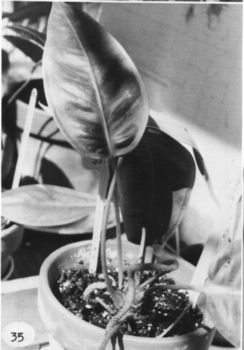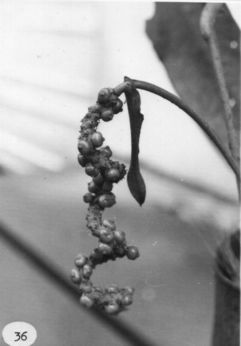





Anthurium circinatum Croat,
Selbyana 5: 317. 1981. TYPE: Panama. Chiriquí: above San Felix along mining road, 18-27 mi. off the Pan-American Hwy., 1,200-1,500 m, Croat 33102 (MO 2389002, holotype; K, PMA, isotypes; Live at MO).
Epiphytic or terrestrial; stems to 30 cm long, ca. 1.5 cm diam.; leaf scars ca. 8 mm wide; roots few, descending, ca. 3 mm diam.; cataphylls medium thick, 3-5 cm long, acuminate, drying light brown (B & K Yellow 5/5), weathering to stiff brown fibers, persisting in the existing leaf axils and a few of the leafless axils.
LEAVES spreading; petioles 6-39 cm long, 2-5 mm diam.; terete or weakly sulcate, minutely speckled; geniculum 6-11 mm long, shaped like the petiole; blades narrowly ovate-oblong or rarely clliptic-oblong, coriaceous, sometimes arched along the midrib, downtumed and acuminate at apex, rounded to obtuse at base, 13-33 cm long, 2-11 cm wide, broadest just below the middle, the margin straight and flat; upper surface matte, sunken glandular-punctate, lower surface glossy to semiglossy, minutely and densely glandular-punctate; midrib narrowly and prominently raised almost to the apex above, then abruptly sunken, paler than surface, flat or prominulous and paler below; primary lateral veins 6-12 per side, departing midrib at ca. 45° angle, sunken above and below, more or less straight to the collective vein, drying prominulous on both surfaces; all lesser veins obscure above, slightly visible below; interprimary veins less obscure on drying; collective vein arising from the base, mostly 3-7 mm from the margin.
INFLORESCENCE spreading or erect-spreading, shorter than the longest leaves; peduncle 7-34 cm long, 1-3 mm diam., flexible, usually shorter than petioles, rarely longer; spathe chartaceous, pale green tinged purplish, oblong-lanceolate to ovate, 2.5-7 cm long, 6-10 mm wide, broadest at the base, short-acuminate at apex (the acumen hooked), rounded to subcordate at base, the margins sometimes turned under, inserted at 10° angle on peduncle; stipe 3-15 (rarely to 30) mm long, ca. 2 mm diam., green, sometimes tinged reddish; spadix light brown usually twisted like a corkscrew at maturity, 4.5-23.7 cm long, 4-5 mm diam. midway, 3-4 mm diam. near apex; flowers rhombic to 4-lobed, 2.8-3.2 mm long, 3-4.2 mm wide, the principal spiral usually with 2-3 flowers visible, 6-7 flowers visible in the alternate spiral, the sides adjacent to the spirals straight, the sides perpendicular to the spirals slightly sigmoid; te-pals matte, minutely papillate, the lateral tepals 2.7-3.3 mm wide, the inner margin slightly concave; pistils pale green, glossy, weakly protruding, the stigma linear, ca. 0.5 mm long; lateral stamens emerging more or less rapidly and irregularly from base to apex before alternate stamens have emerged to middle, weakly exserted on short, fleshy filaments, retracted and held at the edge of the pistil in a tight circle, the anthers pale yellow, ca. 0.3 mm long, 0.6 mm wide, the thecae broadly ellipsoid, slightly divaricate; pollen white. INFRUCTESCENCE more or less pendent, the spathe deciduous, the spadix 15÷41 cm long; berries globose to depressed-globose, red, ca. 8 mm long. Figs. 35 and 36.
The species is known only in Chiriquí Province in lower montane rain forest at elevations from 1,200 to 1,700 m.
Anthurium circinatum is in section Porphyrochitonium and is most closely related to A. chiriquense with which it shares similar flowers with lateral tepals substantially wider in the direction of the axis than perpendicular to the axis. The latter differs in having larger leaves that are acute at the base and narrowly elliptic, 8-12 cm wide and 32-38 cm long. Those of A. circinatum are mostly rounded at the base, narrowly ovate, and usually less than 8 cm wide or, if broader, they are less than 30 cm long (rarely the leaves larger as in Croat 37151).
The species is distinguished by its narrowly ovate to ovate-oblong leaves with the midrib beneath, scarcely or not at all raised, by the red, depressed-globose berries that are beaked at the apex, and by the light brown spadix that is twisted in a coiled manner and becomes corkscrew-like.
Although less closely related to Anthurium circinatum than is A. chiriquense, A. longistipitatum has been confused with A. circinatum. Anthurium longistipitatum was not discovered until after publication of A. circinatum and was included with it in the type description. Thus, that description should be disregarded in preference to the descriptions prepared in this treatment. Plate 6 representing a flowering specimen in the original article (Selbyana 5: 321. 1981), is actually A. longistipitatum whereas Plate 2, showing an infructescence, is A. circinatum. Both species have persistent, disoriented cataphyll fibers, have coriaceous, glandular-punctate blades that are matte above and semiglossy beneath, and both have the upper midribs prominently raised and the lower midrib nearly flat. However, flowering material is distinctly different. Anthurium circinatum has shorter, thicker spadices with matte, light brown flowers that are larger than those of A longistipitatum and broader than long. In contrast, A. longistipitatum has generally longer, more slender spadices with glossy, dark reddish brown to violet purple flowers that are about as broad as long. Anthurium circinatum has dried lateral tepals that are thin marginally and more than two and a half times broader in the direction of the axis than perpendicular to the axis, whereas in A. longistipitatum they are thick marginally and less than two times broader in the direction of the axis.
Additional specimens of both species show the leaves to be different as well; those of A. circinatum are two and a half to five times longer than broad, most commonly narrowly ovate with usually six to 12 primary lateral veins, whereas those of A. longistipitatum are mostly oblong-linear, six to ten times longer than broad with usually 12-20 primary lateral veins.
Anthurium circinatum is superficially similar to A. louisii Croat & Baker from Costa Rica, which has inflorescences with a similar tendency to spiral in a corkscrew fashion (hence the name circinatum) and which also has flowers with tepals turned markedly upward on flowering thus giving the spadix a markedly asperous look. However, that species has broadly ovate leaves and thick margined tepals that are not elongate in the direction of the axis of the spadix.
 |
 |
Bocas del Toro: NW ridge ofCerro Pata de Macho, Sytsma et at. 4967 (MO).
Chiriquí: end of road to Bajo Mono, Folsom el ai. 2248, 2249 (MO);
Cerro Colorado, António 1421, 1512 (MO), Croat 33270
(MO, PMA), 37151, 48462 (MO), Folsom & Collins 1773 (MO),
Folsom et al. 4705 (MO), Mori & Dressier 7844 (MO), Sullivan
398 (MO);
SE slopes & summit of Cerro Pata de Macho, Sytsma el al. 4895
(MO, NY);
Palo Alto, NE ofBoquete, Hammel 5711, 7467 (MO); above San Felix,
Croat 33102 (K, MO, PMA), Mori & Kallunki 5872 (F, MO,
PMA), 5990 (MO).